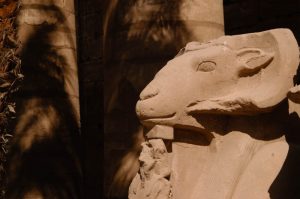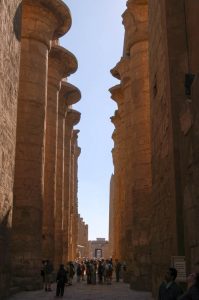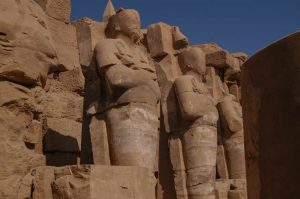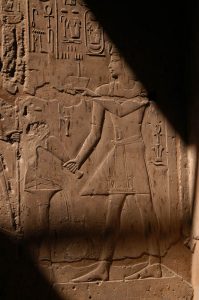Luxor East Bank
A later, more relaxed day than yesterday. Only three things on the agenda, and the rest of the day off. I’m still VERY delicate and eating anything triggers a very bad stomach ache and worse. Not pleasant. That and I’m being eaten alive by mosquitoes. They don’t like Mark. I must be tastier and sweeter than he is.
Temple of Karnak
Karnak temple is enormous – even though we saw it during the Sound and Light show I was unprepared for the sheer size of the place. The Avenue of Sphinxes – ram-headed sphinxes, not human-headed –is truncated now. It once led to the grand promenade of Luxor temple, but is now only a few dozen yards long. The remains have been found between the temples and are now being excavated. The rest of the sphinxes that were found near the temple are inside the courtyard.

Karnak is the only place to see two standing obelisks. The legend is that Karnak temple is the place of Amun’s creation, he created himself here and rose as the sun disk from the eastern sanctuary. Of course, each successive pharaoh (most notably Ramesses II — the Coca Cola Pharaoh — added on until this is a huge complex of many temples and colonnades.
One-hundred thirty-four columns remain in the hypostyle hall, making it feel like a huge, dark forest. Even though the roof is mostly gone, they are so tall and massive that you still cannot see the sky, the sunlight just filters through them so that you stand in twilight even at midday. The columns are in several styles — bud columns, lotus flower columns, reed columns. The bud columns are surprisingly phallic.

Even with the floor plan from the guidebook, it was hard to follow the sprawling layout of the place — the sanctuary is small and magnificently decorated, but the result of the continued building effort over centuries is a structure that is nearly incoherent. Pylon after pylon after courtyard after niche. Some of the pylons are crumbling, and at least one (by the entrance gate) still has the building-ramp of mud brick attached to it.
At the far end is the sacred lake — which was for purification rites. Beyond that is a small shrine to Osiris (manned by two gentleman eager to “bless” you on the seven doors of the hidden false doorway. It is the only one at Karnak. They did, after vigorously blessing us, direct us to the tomb.

Like all large tombs and temples, there are fields of “extra” bits laying in cordoned off areas. This is the “outdoor museum” that is mentioned in the guidebooks. Museum is an overstatement. It looks like they just stacked the pieces they didn’t know where else to put out here in the courtyard. There is no rhyme or reason to it. I am reminded of Tanis, as if some huge hand toppled the walls into piles of rubble.
The Coca-Cola Pharaoh Strikes Again
Ramesses II had his cartouche inscribed on EVERYTHING, sometimes very deeply — since he had replaced most carvings with his own name, he wanted to make sure that no one did that to his carvings. Cartouche after cartouche mar the lower parts of the walls, like the ubiquitous Coca-Cola billboards. If anyone points to a cartouche anywhere, and asks you what it says, guess Ramesses II. You’ll probably be right. More than one of our guides told us that the answer to any question about Egyptology has a 50-50 chance of being Ramesses II!
Luxor Temple and Museum

Luxor museum is very small, maybe only 150-200 major pieces, but they are exceptional pieces, well displayed and well annotated (not much like the Egyptian Museum in Cairo). It is well organized. Some of the sculpted pieces are finer than I’ve seen anywhere else in Egypt. We spent about an hour here and took tons of pictures. They really have a lovely museum.

Like Karnak, Luxor temple is also large and oddly organized (although on a slightly smaller scale that Karnak is.) The avenue of sphinxes that starts here once led to Karnak — and efforts to restore it are underway. Ground level here is some 12-15 feet below the current street level, so most of the temple is sunk below street level and the expectation is that more temples and monuments might be found under the ground of the apartment complexes nearby. There is a mosque built on the stump of a stone pylon inside the temple, the door opening into space almost 20 feet up in the air. The excavation of the temple was accomplished in the last century and they have been working on reconstructions ever since.
We had lunch at Marhaba again — I’m wondering if this is a good idea, given my stomach upsets–and a quick walk on the corniche. We found a pharmacy to buy Mark deodorant and razors, and headed back to the hotel to relax. We sat on the garden walls and enjoyed the sun. I’m a bit ‘templed out’
No dinner tonight. Just a bad movie and bed. We’ve become curiously hooked on Egyptian television dramas (they are like the worst, cheesy, over-the-top ham actor soap operas in the states…in Arabic of course, so we don’t understand a word, but hilariously funny). And, for a muslim country, the music videos (mostly imported from India, I think) are pretty racy.